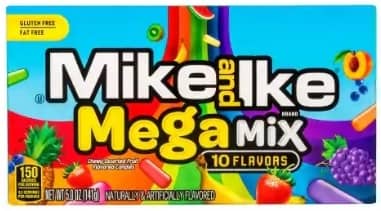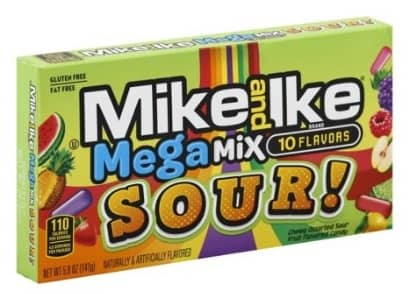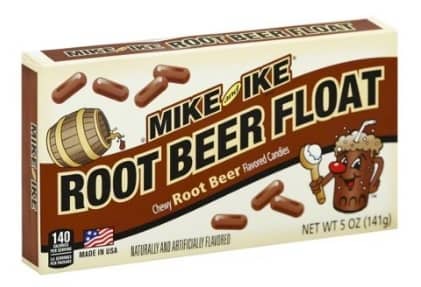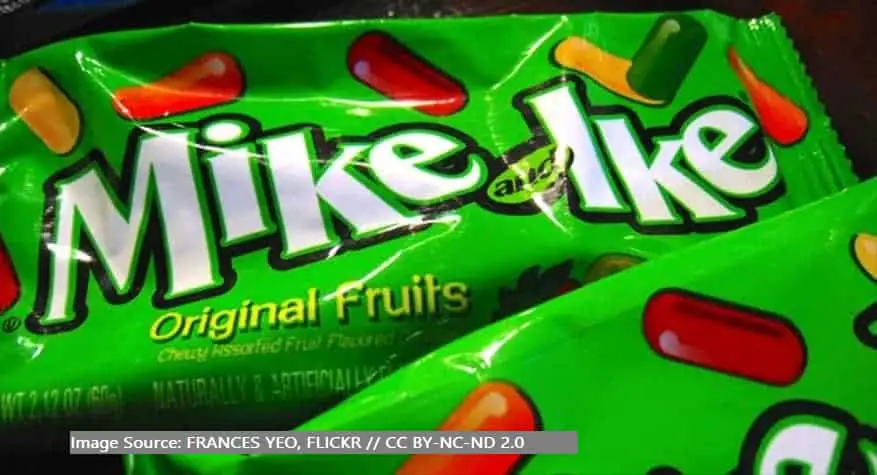Mike and Ike is one of the more popular brands of fruit-flavored candies. They originally only came in fruit flavors, but have since branched out offering more varieties like root beer, etc. You were right to look this up. Chewy candies are notorious for being non-vegan as a number of animal-derived ingredients tend to be used as aerators to achieve a chewy texture in candy making.
Are they vegan? Mike and Ike candies are considered by some to be technically vegan, while others in the community consider the candy to be non-vegan. The controversy comes from the fact that they’re made with confectioner’s glaze which contains shellac–the resin secreted by a female lac bug.
They also contain carnauba wax, which is an ingredient that gets asked about quite a bit as far as its vegan status. Carnauba wax, aka palm wax and Brazil wax, is completely vegan. It’s a wax that derives from the leaves of the palm Copernicia prunifera which is a plant native to northeastern Brazil.1
Hopefully, one day they’ll transition to using only plant-based waxes.
Why Some Consider Mike and Ike Non-Vegan
Mike and Ike Contains Confectioner’s Glaze
Here are the ingredients for the original Mike and Ike candies:2
- Sugar
- Corn syrup
- Modified food starch
- Citric acid
- Malic acid
- Fumaric acid
- Sodium citrate
- Natural and artificial flavors
- Dextrin
- Confectioners glaze
- Carnauba wax
- Medium chain triglycerides
- Red 40
- Yellows 5 and 6
- Blue 1
Unlike some food additives, there’s no real consensus on whether foods containing confectioner’s glaze are considered vegan. Those who say it’s suitable for vegans emphasize that the product is left behind by bugs as they traverse tree branches.
They also point out that the stuff is in numerous food products vegans tend to eat and is even used to coat produce to give it a nice shine and improve visual appeal.
Finally, they point out that it would seem odd that it would be permissible to cut an entire tree down destroying all insects and animals in it, scrape the shellac off of branches to process the tree into building material, but not be able to scrape shellac off of the branch to be used directly.
Those who say it should be avoided, point out that there’s very little difference between using shellac and beeswax–the latter of which having the consensus of being a non-vegan product.
They also point out that it’s highly likely that bugs are killed in large numbers during the scraping process–though it’s not clear how many bugs were collateral damage and how many were already dead left behind in the resin.
Finally, they stress that it is a form of animal exploitation and thus it shouldn’t be considered vegan.
I personally don’t eat candy with confectioner’s glaze because I find the production of the stuff to be too similar to how beeswax is cultivated. But, that’s not to say it’s not suitable for all vegans. I’m just here to present the information.
Why Mike and Ike Is Considered by Some to Be Vegan
Mike and Ike Don’t Contain Egg Albumin
Albumen is primarily found in muscles, milk, and eggs, though it can also be found in certain vegetables.
Albumin (spelled with an “i”) is the actual protein that surrounds the egg yolk.3
Because albumen is found chiefly in egg, it can also be a synonym for egg white. It’s largely composed of protein (albumin) and water. It accounts for upwards of 58% of an egg’s weight.
It’s used as an aerator which makes it good for achieving a chewy texture in candy making.4
Nougat (another popular form of candy) often uses such aerators which accounts for why it’s so hard to find vegan nougat.5
Soy protein can also be used as an aerator but is less common in candy making.6
Anyway, Mike and Ike candy don’t contain any of this stuff.
Mike and Ike Don’t Contain Gelatin
Gelatin is a semi-transparent, flavorless, colorless food ingredient, derived from collagen—the protein that’s found in body parts (the epidermis of the skin, etc.).
Commercially, gelatin tends to be made from animal by-products of the leather and meat industries. Most are derived from pork skins, split cattle hides, and the bones of pork and cattle.7
Like egg albumen, it’s often used as an aerator to achieve a chewy texture in candy. Obviously, gelatin is a no-go for vegans. Luckily for Mike and Ike lovers, it’s not used in this product.
Mike and Ike Don’t Contain Red 4
Red 40 is a dark-red “azo” dye that you’ll often encounter in soft drinks, medicines, and cotton candy, etc. It’s the most commonly used dye in the US for popsicles, sodas, and candy.
It’s often mistaken for Red 4, another red pigment, but one that’s derived from beetles.8
Specifically, Red 4 or carmine is obtained from carminic acid. It’s the carminic acid that comes from beetles.9
Lots of beetles have to be killed just to generate a small amount of the stuff. And, not only is it derived from insects, but its method of production usually involves other animal products including gelatin, egg white, and fish glue.10
Red 40 or Allura red is petroleum-derived (usually), but can be acquired from strawberries.11
So, it’s vegan-friendly.
Other Mike and Ike Varieties and Their Vegan Status
As mentioned above, Mike and Ike have put out a number of varieties over the years. Like the original they’re mostly vegan-friendly with the exception of confectioner’s glaze.
Mike and Ike, Mega Mix Chewy Candy

Ingredients include (not in order of quantity used):12
- Sugar
- Corn syrup
- Modified food starch
- Dextrin
- Fumaric acid
- Fruit juice from concentrate (orange, pear, strawberry, lime, lemon, and cherry)
- Natural and artificial flavors
- Sodium citrate
- Citric acid
- Malic acid
- Artificial color
- Carnauba wax
- Confectioners glaze
- Medium chain triglycerides
- Yellows 5 and 6
- Red 40
Mike and Ike Mega Mix Sour Chewy Candies

Ingredients include (not in order):13
- Sugar
- Corn syrup
- Modified food starch
- Dextrin
- Fumaric acid
- Natural and artificial flavors
- Citric acid
- Malic acid
- Sodium citrate
- Artificial color
- Confectioners glaze
- Carnauba wax
- Medium chain triglycerides
- Yellows 5 and 6
- Red 40
- Blue 1
Mike & Ike Rootbeer

This has largely the same ingredients as the above two and is generally considered vegan.14
It does, however, contain lactic acid which is kind of a grey area.
Lactic acid is an ingredient listed on PETA’s list of animal and potentially animal-derived ingredients.15
It’s an organic acid that’s found in muscles and blood. As such, it can be derived from animals. However, it’s also found in (and often derived from) plants like beets.
Industrially, lactic acid is typically produced via:16
- Chemical synthesis from precursors found in coal and crude oil
- Bacterial fermentation of carbohydrates. Lactic acid bacteria convert simple sugars (glucose, sucrose, and galactose) to lactic acid.
The questionable status of lactic acid stems from how the galactose is sourced. It can be sourced from dairy products but is also found in beets.17
Anyway, the presence of lactic acid doesn’t necessarily render a food product non-vegan. Many vegans choose not to scrutinize additives like this too heavily as there’s really no way of knowing how they’re derived short of contacting the manufacturer directly.
But, this is just something to be aware of if you’re a particularly strict vegan and want to avoid the ingredient.
That’s it for Mike and Ike. Thanks for reading.
You may also want to check out the following articles:
- Are SweeTarts Vegan?
- Are Tootsie Rolls Vegan? What About Tootsie Pops?
- Are Jolly Ranchers Vegan?
- Is Store-Bought Granola Vegan?
References
- Steinle, J. Vernon (September 1936). “Carnauba wax: an expedition to its source”. Industrial & Engineering Chemistry. 28 (9): 1004–1008.
- Original Mike And Ike® | Original Fruits Flavors | Just Born https://www.mikeandike.com/product/original-fruits/
- Understanding Food: Principles and Preparation (Page 250). Amy Brown – Wadsworth Cengage Learning – 2011
- Chocolates and Confections: Formula, Theory, and Technique For the Artisan Confectioner (Page 356). Peter Greweling-Ben Fink – John Wiley & Sons – 2013
- Chocolates and Confections: Formula, Theory, and Technique For the Artisan Confectioner (Page 357). Peter Greweling-Ben Fink – John Wiley & Sons – 2013
- Chocolates and Confections: Formula, Theory, and Technique For the Artisan Confectioner (Page 363). Peter Greweling-Ben Fink – John Wiley & Sons – 2013
- “Natural Health Products Ingredients Database: Hydrolyzed Collagen”. Government of Canada, Health Canada, Health Products and Food Branch, Natural Health Products Directorate. 12 June 2013.
- Bug-Based Food Dye Should Be Exterminated, Says CSPI. https://cspinet.org/news/bug-based-food-dye-should-be-exterminated-says-cspi-20060501
- Carminic Acid https://en.wikipedia.org/wiki/Carminic_acid
- Carmine https://en.wikipedia.org/wiki/Carmine#Production
- Potera, C., 2010. Diet and nutrition: the artificial food dye blues. Environ Health Perspect. 118 (10), A428–A431.
- Mike and Ike, Mega Mix Chewy Candy. https://www.walmart.com/ip/Mike-and-Ike-Mega-Mix-Chewy-Candy-3-4-Lb/755107426
- Mike and Ike Mega Mix Fat-Free 10 Flavors Chewy Candies. https://www.walmart.com/ip/Mike-and-Ike-Mega-Mix-Fat-Free-10-Flavors-Chewy-Candies-5-Oz/110008398
- Mike & Ike Rootbeer. https://www.walmart.com/ip/Mike-Ike-Rootbeer/847743918
- Animal-derived Ingredients Resource | Living. https://www.peta.org/living/food/animal-ingredients-list/
- H. Benninga (1990): “A History of Lactic Acid Making: A Chapter in the History of Biotechnology”. Volume 11 of Chemists and Chemistry. Springer, ISBN 0792306252, 9780792306252
- Galactose. https://en.wikipedia.org/wiki/Galactose#Sources

